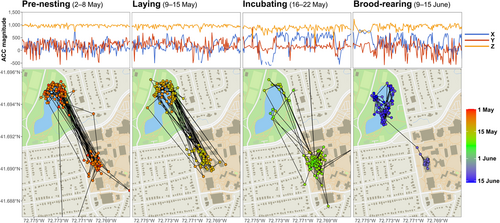Mallards must consider two stages of their hatchlings lives when picking a nest site: nesting, and brood rearing. Due to urban fragmentation, there may not be suitable brood rearing habitat close to chosen nesting habitat.
When habitat quality is poor, this may cause a trade off between habitat selection for nesting or rearing. This study observed brood/ducking survival, brood movements, home range size, and habitat composition to understand how urbanization affects nesting choice and duckling mortality.
The researchers identified nests in their study area (Connecticut) by searching for them at state-managed water bodies. They also recruited public reports of duck nests by use of press releases and social media. This allowed them to identify nests in secluded areas and in densely populated area like yards and public parks. I think this was a very clever method to get a variety of habitat types, involve the public, and gain permission to complete research on private property. Using different methods of nest identification is a good way to avoid bias. This shows how citizen science projects like iNaturalist could be used in tandem with more traditional methods to get more diverse results. After nests were identified, they regularly checked nest count and estimated incubation stage. They also attached GPS backpacks to the adult females during the last week of incubation. They checked the nest after the female had left for more than 12 hours to determine the fate of the eggs. They then found and regularly observed broods until it was determined that the brood was a survival success or failure.

The caption for this figure was slightly confusing, but I believe this is showing a single female’s path throughout nesting and rearing.
The results of this study showed that females can nest successfully in urban areas of Connecticut but experience greater duckling mortality. This could indicate a difficulty with finding or accessing suitable brood rearing habitat. Traveling distance did not affect brood success. Broods relied on wetlands for rearing and often traveled along streams to reach them. This shows the importance of protecting connections between nesting and rearing habitats, and the importance of protecting wetlands and providing adequate cover for young ducklings to avoid predation. This study was very thorough and I found the methods of data collection very interesting. Their use of multiple different methods including citizen science shows a different application that I had not previously considered.
Dykstra, L. R., M. T. Huang, and T. A. G. Rittenhouse. 2024. Mallard brood movements and survival in an urbanized landscape. Journal of Wildlife Management 88:e22578. https://doi.org/10.1002/jwmg.22578: Critical Review of “mallard brood movements and survival in an urbanized landscape”